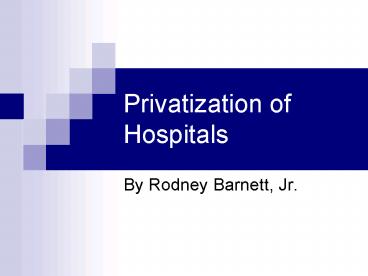Privatization of Hospitals - PowerPoint PPT Presentation
1 / 18
Title:
Privatization of Hospitals
Description:
... and local public hospitals make up only 22% of all hospitals. Federal hospitals make up only 17% of all ... Consolidation Combination of two or more institutions ... – PowerPoint PPT presentation
Number of Views:186
Avg rating:3.0/5.0
Title: Privatization of Hospitals
1
Privatization of Hospitals
- By Rodney Barnett, Jr.
2
Hospital Privatization Trends
- Public hospitals have been declining for 20
years. - Between 1985 and 1995 public hospitals have
declined by nearly 14 - State and local public hospitals make up only 22
of all hospitals - Federal hospitals make up only 17 of all
hospitals
3
Reasons for Privatizing
- Increased competition from private hospitals
- Managed-Care Plans (ie. Medicaid) prefer the use
of Private hospitals - Local governments having trouble financing public
hospitals - Government regulations on public hospitals
- Regulations lower public hospitals ability to
compete - No funding for advertising
4
How Hospitals Privatize
- Sale A direct sale of assets by the public
institution - Lease A lease of the assets by the public
institution - Joint Venture A partnership, government
retaining some rights - Management Contract Management is from an
outside existing institution
5
How Hospitals Privatize (cont.)
- Consolidation Combination of two or more
institutions - Closure Assets are sold and institution is
closed - Affiliation An association between two or more
groups
Source Summary of Findings Privatization of
Public Hospitals. Economic and Social Research
Institution. January 1999. http//www.esresearch.o
rg/Documents/PHExSum.pdf
6
Who Benefits from Privatization?
- The patients benefit directly from privatization.
- Increased competition for patients
- Private hospitals have lowered prices to attract
lower income patients - Managed-Care Plans prefer private hospitals
- Private hospitals have overall newer innovative
systems
Source Tradewell, R. Privatizing Public
Hospitals. Policy Study No. 242. August 1998.
http//www.rppi.org/ps242.html
7
Economic Justification
- Increased competition
- More efficient market in health care
- Better services for patients
- Elimination of certain taxes by the government to
fund these hospitals
Source Tradewell, R. Privatizing Public
Hospitals. Policy Study No. 242. August 1998.
http//www.rppi.org/ps242.html
8
Economic Factors Concerned With Privatizing
- Anti-Trust Policies Does the privatization of
public hospitals violate current anti-trust
policies? - Patients Preferences Typically a patient will
want to attain the highest level of health care
given their budget - Cost-Benefit Analysis Will the costs associated
with privatization be lower than the benefit?
9
Anti-Trust Policies
- Anti-trust policies are one of the leading
factors slowing down privatization - In many rural or smaller areas, a very low number
of hospitals exist - The FTC may view some mergers or acquisitions of
public hospitals as violations of anti-trust
policies - Costs associated with anti-trust legalities may
be greater than the private institution may be
willing to pay
Source Tradewell, R. Privatizing Public
Hospitals. Reason Public Policy Institute. August
1998. http//www.rppi.org/ps242.html
10
Patient Preferences
- If patients are given a choice, they will likely
prefer to be served by a more specialized
institution - This is especially true if the costs are incurred
by insurance or any other indirect way of payment
by the patient
Source Holcombe, R. Public Finance Government
Revenues and Expeditures in the United States
Economy. 1996. http//www.randallholcombe.com/book
.htm
11
Graph of Patients Preferences
D Demand for Public Hospitals D
Demand for Private Hospitals
12
Patient Preferences Graphical Analysis
- In the graph, if patients are given the choice,
and they are to pay for the services, then they
will demand D and pay P. - However, relevant to todays trends, if patients
are given a choice with their insurance companies
and managed-care plan providers, then they will
demand the the slightly more expensive service,
and demand D and pay P, where they will receive
the highest MSB.
13
Patient Preferences Intended Effects
- Higher competition
- Lower prices for services
- Better technology for patients
Source Tradewell, R. Privatizing Public
Hospitals. Policy Study No. 242. August 1998.
http//www.rppi.org/ps242.html
14
Cost-Benefit Analysis
- Policy makers must perform a cost-benefit
analysis in order to see if the investment is
sound - What are the costs associated with privatizing?
Are they lower than what the private institution
is willing to pay?
15
Cost-Benefit AnalysisCosts to Private Hospitals
- Assigning a mergers and acquisitions expert to
investigate the privatization - Resolve legal issues if they arise (i.e.
anti-trust policies) - Taxes, such as property taxes previously not paid
by the public institution
Source Tradewell, R. Privatizing Public
Hospitals. Policy Study No. 242. August 1998.
http//www.rppi.org/ps242.html
16
Cost-Benefit AnalysisBenefits to Private
Hospitals
- Increased patients
- Integration of managed-care plans to pay for
lower income patients
Source Tradewell, R. Privatizing Public
Hospitals. Policy Study No. 242. August 1998.
http//www.rppi.org/ps242.html
17
Conclusion
- The market for health care is becoming more and
more competitive. - The existence of private hospitals are the
reasoning behind the higher competition - In a more competitive market the consumer
benefits, in that higher quality services are
provided for a lower price
18
Works Cited
- Anthony, S. et.al. Summary of Findings
Privatization of Public Hospitals. Economic and
Social Research Institution. January 1999.
http//www.esresearch.org/Documents/PHExSum.pdf - Holcombe, R. Public Finance Government Revenues
and Expeditures in the United States Economy.
1996. http//www.randallholcombe.com/book.htm - Tradewell, R. Privatizing Public Hospitals.
Policy Study No. 242. August 1998.
http//www.rppi.org/ps242.html































